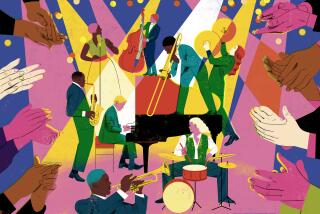Greene Ensemble Not Just Another Classical Quartet : The string musicians inject elements of country, rock and jazz into their new album
The violin has taken Richard Greene in a variety of unexpected and mostly non-traditional directions. Since the late 1960s heâs played fiddle and electric violin behind artists as diverse as bluegrass pioneer Bill Monroe, rockers Bruce Springsteen and Rod Stewart, the orchestras of Henry Mancini and his own improvisational rock act, Seatrain.
But by 1985, Greeneâs hunger for yet another musical direction led him finally to a format he had rarely participated in: the classical quartet.
âI wanted to put something together that satisfied all my musical tastes,â Greene explained recently.
This somewhat ironic turn to the centuries-old tradition of a proper string quartet, after years of pursuing a more modern approach, resulted that year in the Greene String Quartet. It was actually an idea Greene had been toying with since the mid-1970s, even if the needed motivation and outside interest did not materialize until Greene and his violinist wife, Margaret Wooten, joined another musical couple to play four-part string music by Rossini and others for their own enjoyment.
With the addition of cellist Melissa Hasin and Jimbo Ross on viola, the Greene String Quartet barely resembles those earlier days of playing the works of the classical composers, as demonstrated on the new âThe String Machineâ album, just released on Virgin Variations. Instead, the sound draws heavily from the jazz improvisation experience of Greene, Ross and Hasin.
âOur mission wasnât to become another classical string quartet, but to do something different,â said Wooten, a semi-regular presence for the past 10 years with the Los Angeles Philharmonic, the L.A. Chamber Orchestra and other ensembles. âAnd itâs completely thrilling for me, and I am the most classical of all of us.â
Greene and Wooten were talking about the quartet and the new album around the kitchen table of their hillside home, which rests on a cliff above the city and is virtually within throwing distance of the Hollywood sign. Soon, Greene would be leaving in a rush for a recording session at a local studio.
âPlaying in the string quartet was the hardest thing I ever tried to do,â said the bearded Greene, 48. âAnd for the first three years I wondered if this was ever going to be any easier. Itâs because you canât let up, thereâs no rhythm section, all four of us are playing virtually all the time.â
Wooten had been a fan of Greeneâs music for about 10 years before actually meeting him at a 1978 recording session at an A&M; Records studio in Hollywood. As a violin performance student at the State University of New York at Stonybrook years earlier, she listened to Greeneâs Seatrain, she said, as did other âhip violinists. That was like the first rock ânâ roll fiddle any of us knew of. It was magic. We were completely awe-struck with what he did with Seatrain.â
That sort of astonishment among audiences, Greene said, serves as a prime motivation for the quartet. But Wooten added, âFinding the right people to write for us is not the easiest thing.â
âThe String Machineâ is a broad mix of musical styles, including a work by Aaron Copland, crowded with tracks offering elements of country, rock and broad Duke Ellington-style jazz. Their search for modern material led them to the Guns Nâ Roses rock anthem âWelcome to the Jungle,â which launches the new album with surprising energy and drama.
âItâs a very tuneful tune,â Greene said. âAnd Guns Nâ Rosesâ performances are so hard-edged, so you might not see that about them. But thereâs some very melodic stuff, very well-thought-out arrangements. I know, because I went into them note-for-note to bring them to the string quartet.â
The wild variety of the quartetâs repertoire was intentional, Greene added. âEven if at first glance they seem unconnected, thereâs a stylistic connection to all of them,â he explained. âThey all have to do with fiddling or jazz or blues, without exception.â
In the past, the Greene String Quartet has been compared to other modern quartets that have emerged in recent years, including the Kronos Quartet. But Greene distanced his band from that growing group, finding himself in a strangely purist position as other quartets alter their sound by adding guitar and other instruments.
âAll these groups are trying to augment the quartet. Itâs almost a turnoff, because I just love what a quartet can do. To make it have another voice within itself, without plugging it in or adding other instruments is the greatest thrill.â
YER BLUES: Local blues listeners forever seeking a full dayâs shift of the alternately downbeat and uplifting musical form will find their favorite sounds in a pair of upcoming weekend blues festivals in Hollywood and the San Fernando Valley.
First, this yearâs Hollywood Blues Festival, May 25-26, collects a variety of talent, including Ronnie Earl & the Broadcasters, Texas-blues band Margie Evans & Her Blues Thrillers, guitarist Bobby Radcliff, James (Thunderbird) Davis, Rod Piazza & the Mighty Flyers and a dozen others.
The Memorial Day weekend festival is presented at the John Anson Ford Theater in Hollywood. Tickets are $15-$25 per day. For more information, call (213) 498-6942.
Later, the Topanga Blues Festival on June 1 is to feature performances by Floyd Dixon, Billy Vera, Joe Houston, Lowell Fulson, Jim Beasley and Mickey Champion. The one-day festival is to be presented at the Will Geer Theatricum Botanicum, 1419 N. Topanga Canyon Blvd., in Topanga. Tickets are $20-$50. For more information, call (213) 455-2322.
More to Read
The biggest entertainment stories
Get our big stories about Hollywood, film, television, music, arts, culture and more right in your inbox as soon as they publish.
You may occasionally receive promotional content from the Los Angeles Times.











